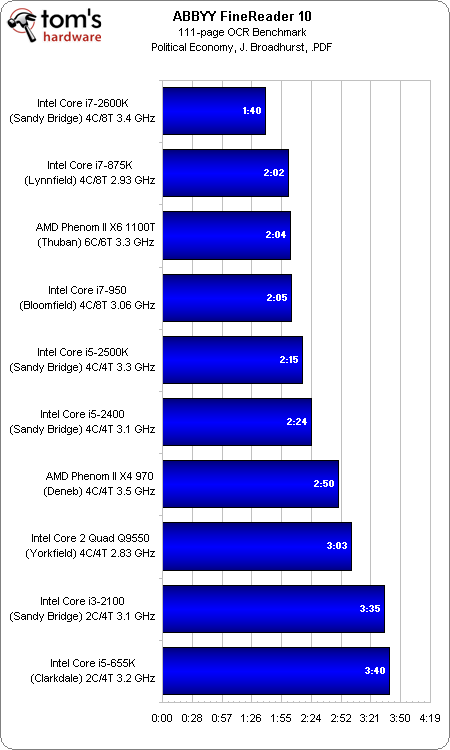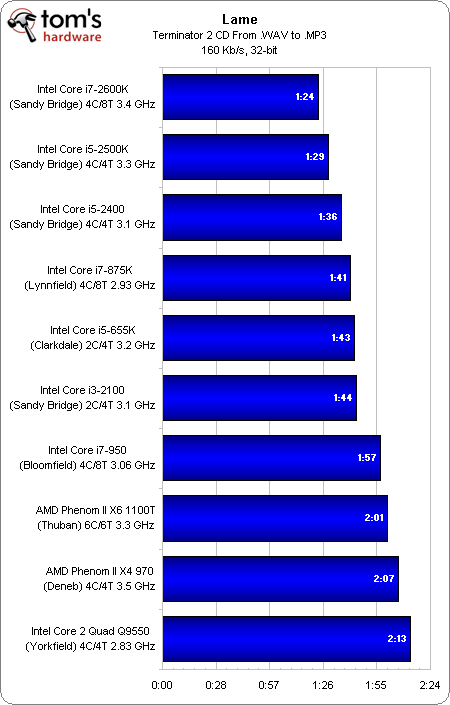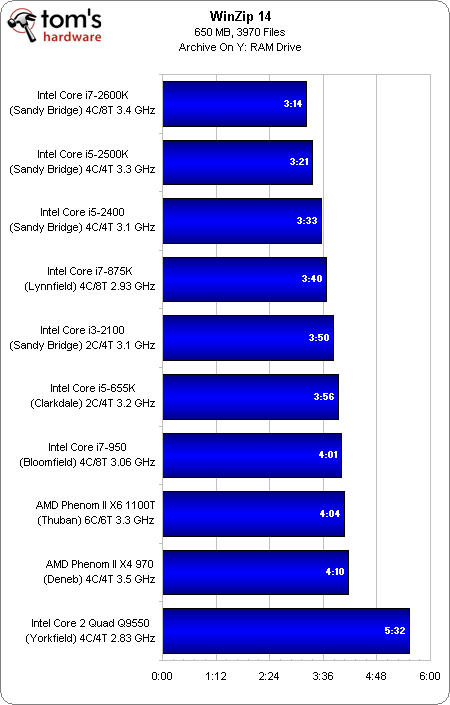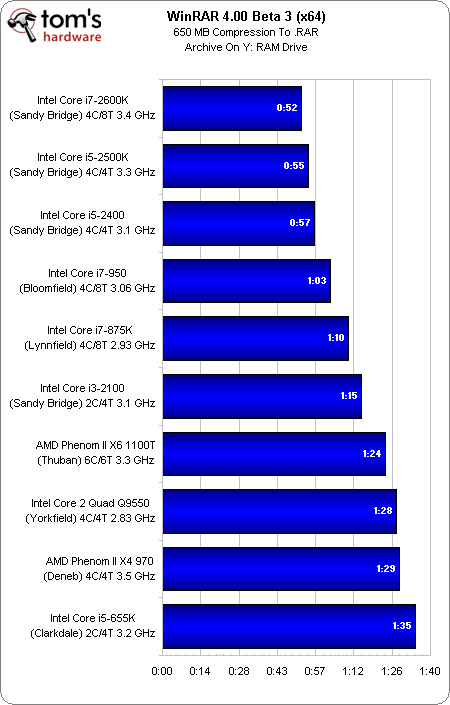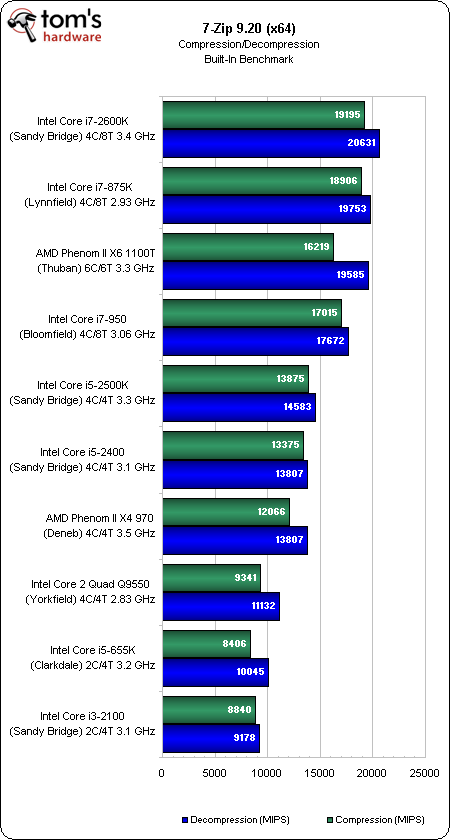Intel’s Second-Gen Core CPUs: The Sandy Bridge Review
Although the processing cores in Intel’s Sandy Bridge architecture are decidedly similar to Nehalem, the integration of on-die graphics and a ring bus improves performance for mainstream users. Intel’s Quick Sync is this design’s secret weapon, though.
Benchmark Results: Productivity
ABBYY’s FineReader 10, an optical character recognition app, was another requested benchmark. We’ve automated the scanning of a 111-page document for testing—a task that apparently really appreciates parallelism.
The top two finishers are quad-core, Hyper-Threading-enabled CPUs, and third place goes to AMD’s six-core entrant. Fourth belongs to the Core i7-950 (Bloomfield), also able to work on eight threads concurrently.
It takes more than twice as long to get this workload completed on either of the dual-core CPUs compared to Intel’s Core i7-2600K.
Another significant comparison here is between the Core i5-2400 and Phenom II X4 970 (both $185 processors). In case you haven’t been keeping score, the i5 has beaten the Phenom II in every single test. It looks like AMD is going to have to drop prices to make its fastest quad-core chip competitive.
I stopped using the Lame benchmark a while back, but it makes for yet another point of comparison (and a decent indication of performance on a clock-for-clock basis, given its single-threaded operation), so I’m including it here.
The scaling falls in line with what we’d expect. As you get down to the Phenom IIs, bear in mind that the X6 1100T has Turbo CORE, which is able to send it to 3.7 GHz in a workload like Lame.
The only other anomaly would seem to be the Core i7-875K. But its 3.6 GHz Turbo Boost ceiling is undoubtedly the reason it beats the Core i5-655K, despite a sizable base clock disparity.
Get Tom's Hardware's best news and in-depth reviews, straight to your inbox.
We phased WinZip out a while ago. But with the release of WinZip 14, Intel got the developer to include AES-NI support. So, we’re putting it back into rotation, alongside the latest versions of WinRAR (no AES-NI support) and 7-Zip (free to use; includes AES-NI).
If you didn’t know any better, you’d think we duplicated the charts for Lame and WinZip. Indeed, it looks like the fine folks at WinZip still haven’t optimized for threading, and so performance is based almost exclusively on IPC throughput and clock rate, rather than parallelism. Boooring.
Thanks to all of our readers who suggested adopting WinRAR 4.00 and 7-Zip 9.20—we’ve upgraded both utilities to the latest versions.
While the results of our WinRAR compression routine don’t look significantly different than the WinZip charts, you will notice that the dual-core Core i5-655K gets knocked down to last place and the Core i3-2100 falls behind the Core i7-950 and Core i7-875K.
Unfortunately for AMD, the six-core 1100T and four-core 970 don’t move up in the standings, despite the threading optimizations in WinRAR. We’re not sure if this is a development issue or not, but there’s a pretty clear tendency toward the new Sandy Bridge processors here.
Rather than run the same set of files through a third compression utility, we took advantage of 7-Zip’s built-in ability to measure each platform’s performance in millions of instructions per second.
Parallelism really benefits the 7-Zip metric, which we set to take advantage of all available threads on each CPU.
Current page: Benchmark Results: Productivity
Prev Page Benchmark Results: Content Creation Next Page Benchmark Results: Media Encoding-
cangelini MoneyFace pEditor, page 10 has mistakes. Its LGA1155, not LGA1555.Reply
Fixed, thanks Money! -
juncture "an unlocked Sandy Bridge chip for $11 extra is actually pretty damn sexy."Reply
i think the author's saying he's a sexually active cyberphile -
fakie Contest is limited to residents of the USA (excluding Rhode Island) 18 years of age and older.Reply
Everytime there's a new contest, I see this line. =( -
englandr753 Great article guys. Glad to see you got your hands on those beauties. I look forward to you doing the same type of review with bulldozer. =DReply -
joytech22 Wow Intel owns when it came to converting video, beating out much faster dedicated solutions, which was strange but still awesome.Reply
I don't know how AMD's going to fare but i hope their new architecture will at least compete with these CPU's, because for a few years now AMD has been at least a generation worth of speed behind Intel.
Also Intel's IGP's are finally gaining some ground in the games department. -
cangelini fakieContest is limited to residents of the USA (excluding Rhode Island) 18 years of age and older.Everytime there's a new contest, I see this line. =(Reply
I really wish this weren't the case fakie--and I'm very sorry it is. We're unfortunately subject to the will of the finance folks and the government, who make it hard to give things away without significant tax ramifications. I know that's of little consolation, but that's the reason :(
Best,
Chris -
LuckyDucky7 "It’s the value-oriented buyers with processor budgets between $100 and $150 (where AMD offers some of its best deals) who get screwed."Reply
I believe that says it all. Sorry, Intel, your new architecture may be excellent, but unless the i3-2100 series outperforms anything AMD can offer at the same price range WHILE OVERCLOCKED, you will see none of my desktop dollars.
That is all.
